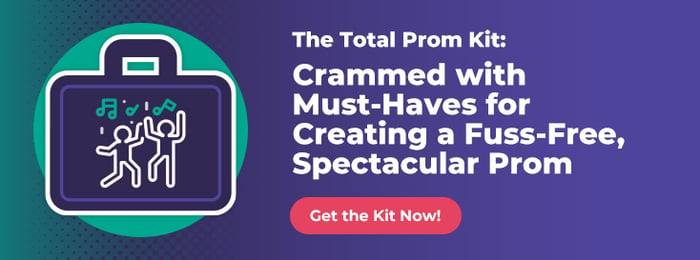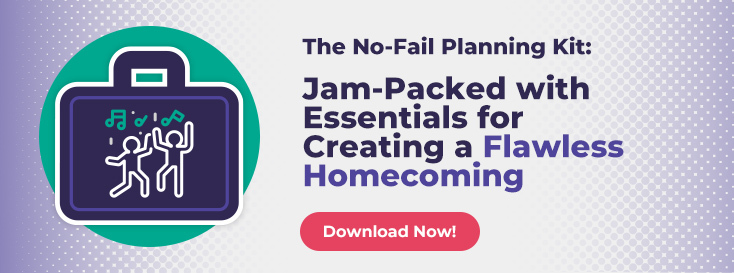Introduction
A prom chaperone is a school-approved adult who supervises students at prom, ensuring everyone follows school dance rules, supports student safety, and manages any unexpected incidents. Their presence helps create a memorable yet secure prom night.
This article will discuss why schools need chaperones, typical responsibilities, and dos and don'ts to ensure that kids are supervised and to help everyone have a safe and fun time.
Table of Contents
- Why Schools Need Prom Chaperones
- Prom Chaperone Responsibilities
- Dos and Don'ts for Prom Chaperones
- Prom Chaperone Styles: Balancing Authority and Approachability
- Training & Pre-Event Briefing Tips
- FREE Prom Chaperone Responsibilities Checklist
-
10 More FREE, Must-Have Prom Planning Tools & Templates to Save Time
Why Schools Need Prom Chaperones
A prom chaperone offers several benefits on a senior's big night. Here are some to consider.
Supervision Ratios and Legal Expectations
Although prom chaperones are not a legal requirement, they can help schools meet certain obligations as follows:
- Duty to Supervise: Schools are legally obligated to provide a safe environment for students under their care. Chaperones fulfill this need.
- Safety and Wellbeing: Chaperones ensure safety, helping prevent incidents and responding promptly to emergencies.
- Rule Enforcement: A chaperone ensures that students follow the rules regarding drinking, drug use and dress code.
Risk Management and Student Safety
Schools are liable for student injuries that occur due to negligence. Adult prom supervision is necessary as chaperones can spot and stop unsafe behavior, reducing the risk. They promote prom safety and support a safe and healthy environment.
Volunteer Requirements (Background Checks, Briefings)
Chaperones must be trained and background checked to ensure they don't pose a threat to students and understand their duties clearly. Here are some steps schools can take to ensure a safe experience.
Background Checks
A Sentencing Project study reveals up to 100 million Americans (around one in three) have criminal records. Not every crime makes someone unfit to serve as a prom chaperone, but schools should conduct background checks to ensure the candidate is suited for the task.
Background checks examine a person's history. They can determine prior arrests and convictions, past employment, and education verification. However, in a school setting, the priority is to ensure the chaperone does not endanger the students.
To conduct a background check, the school must first have:
- Get written permission from the individual
- Gather necessary information like the person's full name, date of birth, social security number, and past addresses
- Select a provider—Choose a recommended provider that offers personal background checks as opposed to employee background checks. TruthFinder and Checkr are two popular options.
- Review the information: The provider will produce the report, but it's up to the school to determine if the individual meets their needs based on their findings. Decide whether the person is qualified to be a prom chaperone, considering their past behavior.
- Give yourself enough time. Background checks typically take 1-3 days, but could take longer. Plan ahead to ensure you get the results back well before prom time.
Briefings
Next, the school must brief the individual to ensure they understand the rules of chaperoning and what's involved. Here's what the process may entail.
- Familiarity with Rules and Regulations: The priority is ensuring the person understands prom rules and regulations. This could involve anything from dress codes to substance issues to students physically putting themselves and others in danger.
- Event Overview: Ensure the chaperone understands what the event entails and whether specific procedures are necessary. This helps them know what to expect and ensures they look for risks in specific circumstances.
- Emergency Procedures: Chaperones should understand how to react if an emergency occurs. They should be ready to provide first aid or call 911 if necessary.
- Student Interactions: There may be times when a student acts out and resists the chaperone's requests. The chaperone should understand student psychology to make exchanges copasetic.
Prom Chaperone Duties: Before, During, and After the Event
Prom is one of the most memorable events in a student's high school journey. As a chaperone, your role is pivotal in creating an environment that's fun, memorable, safe and secure. Schools trust you to uphold their standards and ensure the prom event runs smoothly.
Here's a quick guide to your key responsibilities:
Pre-Prom Duties
Pre-prom duties include:
1. Pre-Prom Briefing
Chaperones may attend meetings and receive materials, preparing them for prom night. They may also attend a mandatory briefing session, typically held 30-60 minutes before prom.
During this time, you should familiarize yourself with chaperone prom rules, emergency exits, venue layout and safety procedures to be fully prepared for unexpected events.
2. Arrival Duty
Chaperones keep students safe and contribute to the fun, greeting students as they arrive.
Assist students in checking tickets or the guest list, greeting attendees warmly, and briefly reviewing essential prom night duties and expectations. Pay attention to early indicators of issues such as intoxication or inappropriate attire.
3. Emergency Preparedness
Be prepared for prom night emergencies by knowing emergency exit locations, first-aid kit stations, AED (Automated External Defibrillator) placements and having emergency contacts handy. Review the school's emergency protocols prior to the event.
4. Communication
Maintain constant communication with other prom chaperones and school administration using walkie-talkies or mobile devices. Report incidents or unusual behavior promptly to prevent them from getting out of hand.
During Prom
5. Supervision
Provide active supervision by regularly circulating key areas such as the dance floor, restrooms and exits. This visibility helps supervise prom attendees and address issues promptly.
6. Rule Enforcement
Ensure strict adherence to school policies, including dress code, respectful conduct, and no-substance-use rules. Firm but friendly enforcement of these prom night safety guidelines ensures a safe environment.
7. Coordination with Other Chaperones
Establish regular communication and coordination with other chaperones and staff members to ensure cohesive supervision throughout the event. Regular check-ins and collaboration help ensure a consistent and unified approach to prom safety and student well-being.
8. Student Assistance
As a prom chaperone, be readily available to assist students with any questions or concerns they may have throughout the prom. This can range from providing directions around the venue to helping with minor emergencies like wardrobe malfunctions.
Post-Prom
9. Departure Duty
As the event draws to a close, ensure that all students leave the venue safely. Coordinate with transportation services as needed and verify that each student has a safe and reliable way to reach their destination, whether headed to an after-party or just going home.
10. Post-Event Debrief
After the prom concludes, actively participate in a debrief session with the school administration and other chaperones. Share your feedback on the event, including any challenges encountered and suggestions for future improvements. You can even include a prom survey to gain valuable feedback. This process will help improve future events.
Dos and Don’ts for Prom Chaperones
Following these simple Dos and Don'ts can help chaperones balance their responsibilities, ensuring students have fun and stay safe throughout prom night. Being prepared and proactive makes supervising prom attendees easier and contributes positively to everyone’s experience.
| DOs for Prom Chaperones | DON’Ts for Prom Chaperones |
|---|---|
| Attend chaperone training before prom night to clearly understand your responsibilities. | Don’t wait until prom night to ask about your chaperone duties. |
| Carry a flashlight to easily supervise dimly lit areas like hallways or parking lots. | Don’t assume all areas will be brightly lit or easily visible. |
| Dress professionally to set a good example for students and reinforce your authority. | Don’t dress too casually, as it may affect students’ perception of your role. |
| Communicate clearly with students about rules and expectations, keeping interactions friendly but firm. | Don’t use harsh language or raise your voice when enforcing school dance rules. |
| Keep your phone charged and ready for quick communication during prom night emergencies. | Don’t become distracted by your phone or use it for personal tasks during supervision. |
| Work closely with other chaperones to provide coordinated supervision throughout the prom. | Don’t leave your assigned supervision area without informing another adult. |
| Take notes of any incidents clearly and immediately, so you can easily recall details later. | Don’t rely solely on memory to report issues to school administrators. |
| Be approachable and supportive, helping students who have questions or feel unsafe. | Don’t ignore students’ concerns, even if they seem minor or unimportant. |
| Follow through on departure duties, ensuring all students leave safely at the end of prom. | Don’t leave your post early or without coordinating with other high school dance supervisors. |
| Do have fun — although your primary goal is keeping kids safe, you should be prepared to take pictures, mingle, and dance a little. | Don’t take pictures and post them on social media — doing so may be considered inappropriate. |
| Do remind students to be careful. This is your top priority. | Don't overreact. Students may do some daring things at prom, but your main priority is to draw the line when they put themselves or others in danger. |
Prom Chaperone Styles: Balancing Authority and Approachability

Strict vs. Friendly Chaperone Styles: Pros & Cons
Finding the right balance between strict and friendly approaches helps you handle your prom chaperone responsibilities effectively, creating a safe, comfortable and enjoyable prom environment for everyone. Here's an overview of the pros and cons of each approach
| Chaperone Style | Pros | Cons | When to Use |
|---|---|---|---|
| Strict |
|
|
Best for situations requiring firm enforcement, like rule violations or safety issues. |
| Friendly |
|
|
Ideal when interacting socially, assisting with minor issues, or encouraging a relaxed atmosphere. |
How to Find the Balance
The key is finding a balance between the two. Here are some tips that will help you achieve that goal.
- Warmly Deliver Expectations: Students must understand expectations, but there's no need to be strict or gruff. Greet them warmly when they enter and establish boundaries. Then wish them a fun night.
- Be Professional Yet Approachable: Communicate with students while maintaining a professional demeanor, ensuring everyone has a pleasant experience. Remind them of safety rules when necessary.
- Enforce Rules with Kindness: There's no reason to yell when you notice unsafe behavior. Simply remind the student that you are enforcing rules for their own good.
- Pick Your Battles: Students will let loose on prom night, and you shouldn't discourage them from having a good time. Limit your interruptions to instances when you see potential danger.
When to Intervene and How
A school event chaperone should only intervene when they recognize a potentially or imminently dangerous situation. Their approach varies based on the type of incident. Here are some examples:
- Students are Blocking Emergency Exits: Remind the students to stay out of that area for their own safety.
- You Notice Signs of Drinking, Drug Use, or Intoxication: Substance use is typically strictly forbidden at proms. If you suspect a student is impaired or in possession of drugs and alcohol, discreetly remove them from the prom. If things escalate, call in another adult. Considering 87% of teens report their friends are more likely to drive drunk than call home for a ride, prom chaperones should be especially careful to ensure intoxicated teens stay off the road.
- A Fight Breaks Out: Unfortunately, fights and violence are all too common at schools. An NCES study reveals 22% of high school students were involved in a physical altercation within the past year, and 8% say these incidents have occurred on school property. Fights should be broken up promptly and the students involved should be removed and sent home.
- Medical Emergencies: These incidents can happen for any reason, but at a prom, they are typically related to choking, dehydration, and overcrowding. Chaperones should be trained to deal with each incident accordingly.
- Student Interactions: Students should not do anything to make their peers uncomfortable. If you think one student feels threatened by another in any way, separate them, address the issue, and remove the offending student if necessary.
Prom Chaperone Task Checklist
| ✔️ | Task |
|---|---|
| ☐ | Complete background check |
| ☐ | Attend mandatory pre-prom briefing |
| ☐ | Review venue layout, emergency exits and safety protocols |
| ☐ | Ensure communication device (walkie-talkie or phone) is charged |
| ☐ | Arrive 30–60 minutes early |
| ☐ | Assist with check-in (tickets, guest list) |
| ☐ | Monitor for early issues (e.g., intoxication, dress code violations) |
| ☐ | Confirm location of first-aid kits and AED |
| ☐ | Circulate key areas during event (dance floor, restrooms, exits) |
| ☐ | Enforce school rules (no substances, proper behavior, dress code) |
| ☐ | Coordinate regularly with other chaperones |
| ☐ | Be available for student questions or concerns |
| ☐ | Record any incidents clearly and promptly |
| ☐ | Ensure students leave safely at the event’s end |
| ☐ | Participate in post-event debrief with school staff |
Need to Edit, Expand or Adjust the Checklist?
We've got you covered. Download the free Doc now!
Free Responsibilities Template
"I didn't know what to do at prom!" Sound familiar? Teachers, PTA, and community chaperones often feel lost on prom night. Give them the clarity they need with our customizable Prom Chaperone Checklist Template, which is already filled out and ready for your school's tweaks.

Download Now!
Training & Pre-Event Briefing Tips

Before the big night, every prom chaperone should participate in a short but focused training session. This meeting—usually held 30 to 60 minutes before the event—helps prepare volunteers by reviewing key school chaperone responsibilities and what to do in different situations. A well-run briefing ensures that every high school event goes smoothly and safely.
Sample talking points for your chaperone training:
-
Location of emergency exits, first-aid kits, and AEDs
-
School rules for student behavior and dress code
-
How to handle and report prom night emergencies
-
Where chaperones should be stationed and when to rotate
-
How to log and report incidents (use of radios, phones, or forms)
-
What to do if a student appears intoxicated or distressed
-
Dress code expectations for chaperones
-
Communication protocol with school administrators and security
-
Reminders about being alert, approachable, and consistent
-
End-of-night duties and final venue walkthrough instructions
Final Thoughts
Prom is a special event for seniors. A prom chaperone ensures the night goes off without a hitch, but preparation is necessary. Chaperones should undergo background checks, attend debriefings to ensure they know how to deal with specific situations, familiarize themselves with the venue layout, and strike a balance between enforcing rules and maintaining a fun environment.
Vanco's prom planning tools can help. They provide guidance, ensuring chaperones are ready for the big night. These resources save time and ensure success at the big event.
12 Free, Must-Have Prom Planning Tools & Templates to Save Time
Planning a prom can be a real burden for everyone involved. That's why we built a free kit to help you pull off the big event! It has everything you need, including:
-
148 Fundraising Ideas: Creative ways to raise funds for prom.
-
Theme Ideas: Popular prom themes with decor tips.
-
Promotional Flyers: Customizable flyers to promote your event.
-
Budgeting Spreadsheet: Easy-to-use budget tracker.
-
Prom King/Queen Voting Templates: Materials to organize voting.
-
Safety Guidelines: Essential prom safety tips.
-
Feedback Survey Template: Collect attendee feedback easily.
-
Vendor Negotiation Tips: Tips for securing vendor deals.
-
Emergency Plan: Guide for managing event emergencies.
-
Chaperone Handout Template: Clear list of chaperone duties.
-
Thank You Card Templates: Show appreciation to supporters.
It's about being smart and efficient in your planning approach. Get this kit now and start shaping a prom experience that's memorable for students and seamlessly organized.














.jpg?width=450&height=250&name=School-event-planning-checklists_thumbnail%20(1).jpg)
.jpg?width=450&height=250&name=VF802PR-PC_thumbnail%20(1).jpg)




